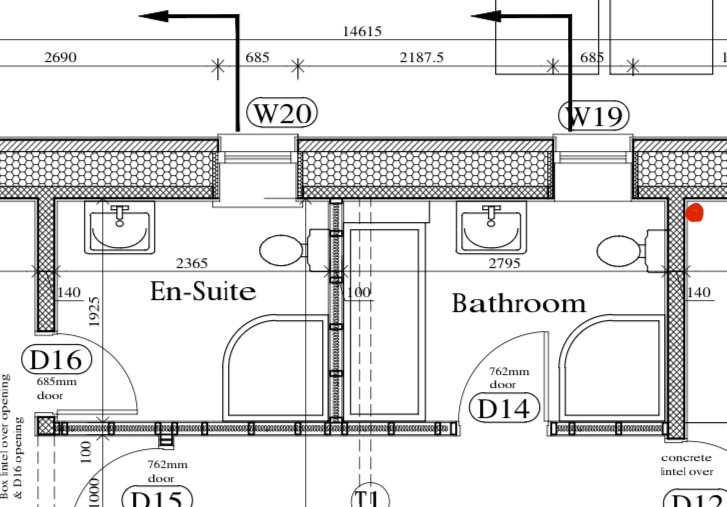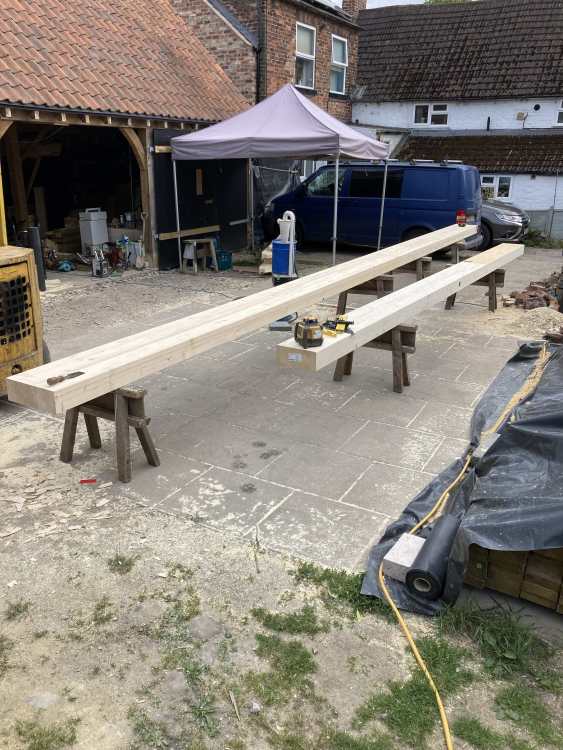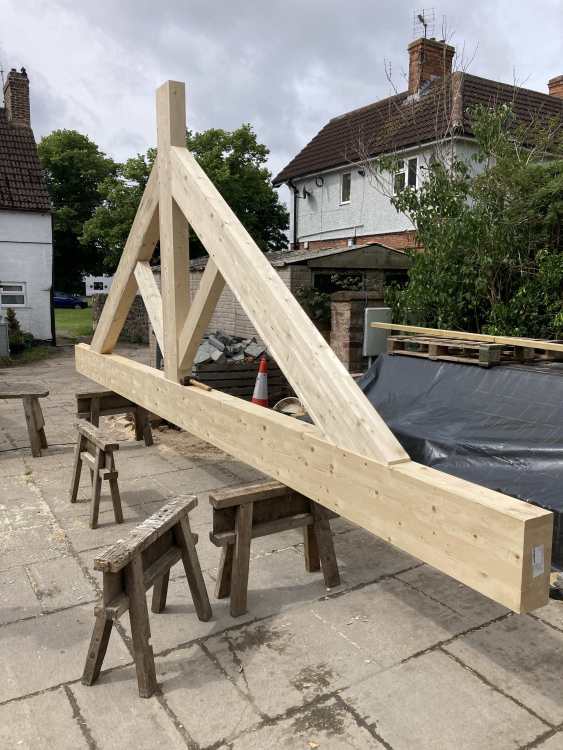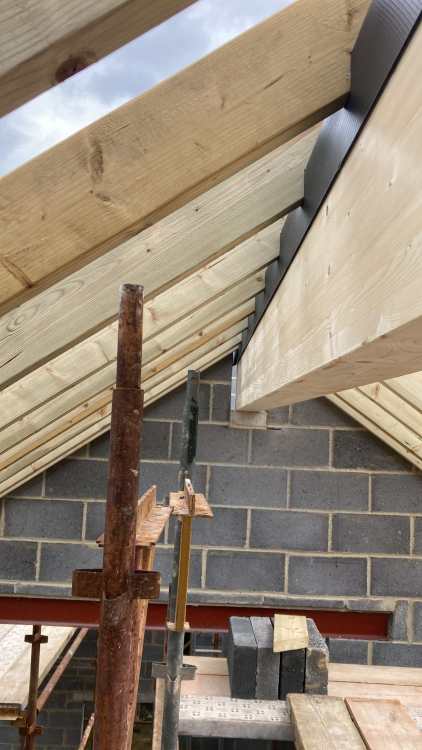
Rishard
Members-
Posts
170 -
Joined
-
Last visited
Recent Profile Visitors
The recent visitors block is disabled and is not being shown to other users.
Rishard's Achievements

Regular Member (4/5)
28
Reputation
-
First floor bathroom / bathroom en-suite wastes
Rishard replied to Rishard's topic in General Plumbing
Great. This makes much more sense than trying to run multiple individual wastes back to the stack. I want them all to be ran in the floor void to keep the rooms as clear as possible. Would I be right in thinking all these bends / connections want to be solvent welded connections? -
First floor bathroom / bathroom en-suite wastes
Rishard replied to Rishard's topic in General Plumbing
I agree, main soil stack can be dog legged to come up in the bathroom which makes sense. Are you saying the 2 toilets should have their own 110mm run rather than joining together before joining the stack. Once the en-suite toilet waste is in the joists, is it ok to join on to this run with say the shower waste? Would I use a strap boss onto the 110 or is there a better method? -
First floor bathroom / bathroom en-suite wastes
Rishard replied to Rishard's topic in General Plumbing
Excuse the badly written title. Can’t seem to change it now it’s live. -
Hello, just scouring the web / forum for similar ideas relating to first floor waste runs. I’m trying to work out the best way to route my waste pipes back to my stack. Is it best to try group the en-suite shower/basin/w/c into one 110mm pipe and back to the stack, or keep w/c separate from the basin and shower? From my research, these could step up to 50mm pipe from the basin/shower and back to the stack. OR Should I be trying to group say the w/c from the en-suite and the bathroom on the same 110mm run to the stack? Keeping the en-suite basin / shower on one 50mm run and do the same for the bathroom? I have posijoists which I can route most of these runs in. The w/c near my stack could go through the wall if beneficial. I’d also take some advice on good way to fix all this pipework to the posi joists. I thought about using some rips of ply to use as a side wall which I could clip / fix pipes to (on a fall) but if there are any other good bracket fixings people have used which would take up less space I’d be interested to know. Has anyone used much dampening on the larger soil pipes to reduce noise? Just a thought as the stack is currently coming up in the corner of a bedroom. This could be adjusted to come up in the bathroom if it makes more sense. Thanks for any insights. Stack highlighted red
-
Aluminium Gutters / Soffits - Who to use?
Rishard replied to boxrick's topic in Roofing, Tiling & Slating
@Russell griffiths what roof system / covering is that? Looks brilliant. -
Closing cavity at the top for blown beads
Rishard replied to MortarThePoint's topic in Heat Insulation
I was aware of the fire issue in clear cavities. It’s mostly the moisture issue I was concerned with, if it is a concern at all? -
Closing cavity at the top for blown beads
Rishard replied to MortarThePoint's topic in Heat Insulation
Other than preventing air movement and in some cases blown beads, is there any other reason to close of the cavity where it connects with the roof insulation? I know mineral wool is none combustible so fire spreading isn’t an issue. Is moisture travelling from the cavity wall upwards towards the roof insulation a concern at all? I’m detailing my wall junctions similar to @Mr Blobby with mineral wool. Below my rafters I will have my vcl which prevents moisture moving into the roof. I hadn’t thought about moisture moving from the cavity at eaves and the gables into the roof insulation. -
There is a ridge board above the glue lam which the rafters are all fixed to so there are no holes in the dpc. It’s also stuck down with airtightness silicone. Would have used a ‘smart’ membrane similar to the vcl which I’ll be using but didn’t have any to hand. Felt the dpc would be better than a roofing membrane out of the 2 available materials to hand.
-
It’s dpc. It will tape into my vapour control layer once the osb is attached to the ceiling. I was just going to tape the vcl to the beam but figured this would be a lot easier.
-
My longest ridge beam is only 6m. I’ve used glue lam throughout as I love the look of it. I’m actually lifting them up tomorrow so I’ll get some pictures. I also built a gluelam truss just to give a bit of a wow factor as it’s above the main enterance at full height from ground floor to the ridge. I actually joined a couple of glue lams, they join on a masonry wall. That beam is now 10m long. My supplier could supply up to 15m I think but I would struggle to lift my beam in at 10m. My engineer calculated my beams and I basically doubled the height mainly for aesthetics. I think I could have gone deeper still. Here are a few pics:
-
Likewise with mine. It’s a racking layer. Not required where I am but it only cost me £400 for the osb. If I’m able to osb the underside first, it’ll give me a great base to snug the mineral wool into. I can then tape my vcl to it from below as it’ll be a good flat surface to work with without having any bulges from the mineral wool.
-
@ProDave Did your frame therm come in slabs or on the roll? Did you need to make these shorter lengths to handle or could you put up large sections in one? Did it require any temporary support before you put the osb up? Good to know there is an alternative way if I decide to insulate from below. I’m also using Knauf as I find it much nicer to handle. I’m using 150mm Knauf batts in my cavity so I can also use up some of my remaining bits of insulation for between my rafters.
-
I would start with finding out what size your rafters need to be. Mine had been oversized by the architect to accommodate more insulation. Moving to a warm roof allowed me to reduce these and thermally break them with insulation over the top. I’d think full filling your rafter depth with a mineral or blown material will ultimately be easier to do. Mines a gable to gable with 1 small valley section. If there were dormers or hips, pir in between would become even more tricky.
-
@Crofter I will indeed nail up the osb first when I get a couple of clear dry days. I’ll then cut my rafter roll insulation to my rafter spacings and roll it in, followed by the pir over the top. Working from above as you say. Mineral wool still isn’t great but at least it won’t be flapping down in my face with reduced ventilation.
-
I’ll chime in on this as what you’re proposing is very similar to what I’m about to undertake. Robins method requires a lot of skill and accuracy. I’ve done dozens of roofs with cut PIR between. It’s horrible. Not to mention difficult to achieve the level of accuracy. Gapo tape does help with this somewhat but comes at a very high cost. Cutting 100mm pir is hard to maintain accuracy, I have the fancy festool insulation saw and even this isn’t perfect. I’ve done 70mm sheets on my table saw where I can make repeat cuts. Doubling up sheets can help achieve your thickness. Even when every rafter is meticulously fixed and spaced there always seems to be a slither of light that gets through somewhere. If you’re prepared for cutting lots of pir and buying a boat load of gapo tape then his method is great. For me, buying Pir is by far the cheapest method of insulating sadly, combined with its uvalue it’s very appealing. Using the full sheets over the top seems to be the best solution for pir, minimal cuts and thermally breaking the rafters. I have 180m2 of warm pitched roof to insulate and I’m working to a similar principle to you. It won’t be everyone’s cup of tea but I’ve researched and costed out multiple versions of insulating this roof. I’ve had advise from my phpp designer and condensation risk calcs done. They all state the most breathable material to the outside however the VCL changes everything. Obviously it needs to be bullet proof which may be hard if your contracting this work out. For me, being the builder on this, I’m very confident I can achieve an excellent vcl in my roof build up. Height is also and issue on my project as some areas already have low eves ceilings on plan and the ridge height is already decided upon on planning. (Had I known what I know now when I put in planning 6 years ago….) My build up is 120mm pir over rafters in 2 layers to stagger the joints. 145mm rafters full filled with Knauf mineral wool. 11mm osb below vcl service void. I know the risks. I’m willing to take it. The condensation risk came back ok with an effective vcl. For me, it’s mainly cost and simplicity of installation that ruled. I got a uvalue of 0.1 with the above. Also have mvhr planned. I costed out dozens of alternative blown cellulose and wood fibre options. They bother required much greater rafter depths which double my timber price. Wood fibre came in at twice the price of pir for half uvalue for thickness. I know all of the above have different characteristics and achieve varying uvalues and that uvalue isn’t only thing to consider. Everyone’s circumstances are different on their project, sometimes a bit of context may help. Who’s installing the roof? Who’s installing the insulation? What do you have on your plans? What u-value do you need? What’s your budget? If I had the money and roof height weren’t an issue I would go wood fibre over engineered rafters with blown cellulose allday.





